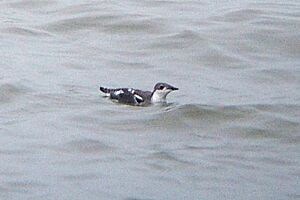Long-billed murrelet facts for kids
Quick facts for kids Long-billed murrelet |
|
|---|---|
 |
|
| Conservation status | |
| Scientific classification | |
| Genus: |
Brachyramphus
|
| Species: |
perdix
|
 |
|
The long-billed murrelet (Brachyramphus perdix) is a small seabird that lives in the North Pacific Ocean. It belongs to the auk family, which are birds that spend most of their lives at sea. The name Brachyramphus comes from ancient Greek words meaning "short bill." The word perdix is Latin for "partridge," because the scientist Pallas thought it was about the size of a partridge.
This bird is quite unusual because it often builds its nests far away from the ocean, deep inside old forests. Like its relatives, the marbled and Kittlitz's murrelets, the number of long-billed murrelets has been decreasing recently. For a long time, people thought the long-billed murrelet was just a type of marbled murrelet. But in 1998, scientists found that their DNA was different enough to make them separate species.
You can find this species from the Kamchatka Peninsula in Russia to the Sea of Okhotsk. Most of these birds travel to the seas around northern Japan for winter. Some even go as far as South Korea and southern Japan.
Contents
What Does the Long-billed Murrelet Look Like?
The long-billed murrelet is a small, plump auk that is about 25 cm (10 inches) long. It has a thin, black bill and pointed wings. Its plumage (feathers) changes depending on the season.
- Winter Look: In winter, its belly is white, while its head, neck, wings, and back are black.
- Summer Look: During the breeding season, its feathers are mostly brown. The edges of its feathers are lighter, making it look a bit scaly. The middle of its belly, which is usually underwater when it swims, stays white.
The long-billed murrelet is a bit bigger and heavier than the marbled murrelet. It also has a white ring around its eye. When it's in its summer feathers, it has a pale throat, which the marbled murrelet does not. In winter, it doesn't have the white collar that the marbled murrelet has.
Measurements:
- Length: 25 cm (10 inches)
- Weight: 310 g (about 0.7 pounds)
- Wingspan: 43 cm (17 inches)
Life Cycle and Habits
The long-billed murrelet eats small fish. It finds its food in the ocean, both far offshore where ocean currents bring nutrients to the surface, and closer to shore in calm bays. It tends to travel more than its close relative, the marbled murrelet.
The way long-billed murrelets raise their young is very unusual for a seabird. They do not gather in large groups to breed. Instead, they often nest far from the sea, high up on the branches of old conifer trees. They lay just one egg on a thick branch covered with lichen or moss. The parents take turns keeping the egg warm for about a month. After the chick hatches, it is fed for around 40 days. Then, it fledges (learns to fly) and flies by itself to the ocean.
Why Is This Bird Important?
The long-billed murrelet is considered a globally threatened species. Its numbers have gone down across its habitat in recent decades. The biggest danger to these birds is the loss of the old forests where they nest, mainly due to logging. They can also get caught in fishing gear. There is also concern that oil drilling in the Okhotsk and Bering Sea could harm them.
Traveling Far From Home
This species is known for traveling very far from its usual ocean home. Sometimes, these birds are seen in places like North America and Europe, often far inland on lakes and rivers, hundreds of kilometers from the sea.
For example, there have been about 40 sightings in North America. Some were on the Pacific coast, which is expected. But others were scattered across the continent, in states like Florida, Pennsylvania, New York, Ohio, and Kansas.
In Europe, the first long-billed murrelet was found in Switzerland in 1997. Another was seen in Devon, England in 2006. This bird attracted many birdwatchers who traveled from far away to see it. A third bird was found in Romania in late 2006.


